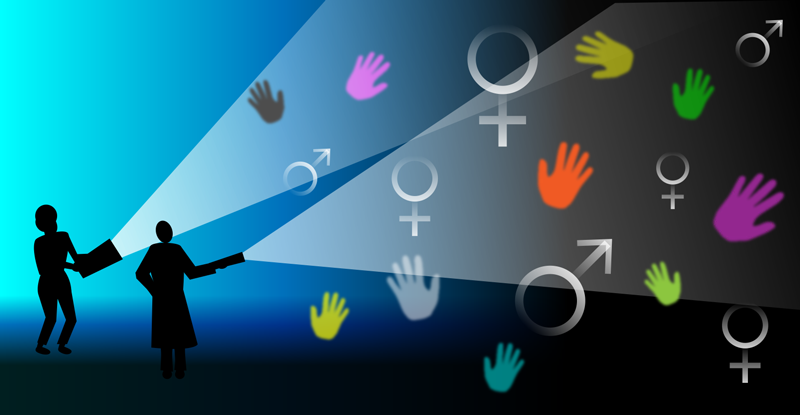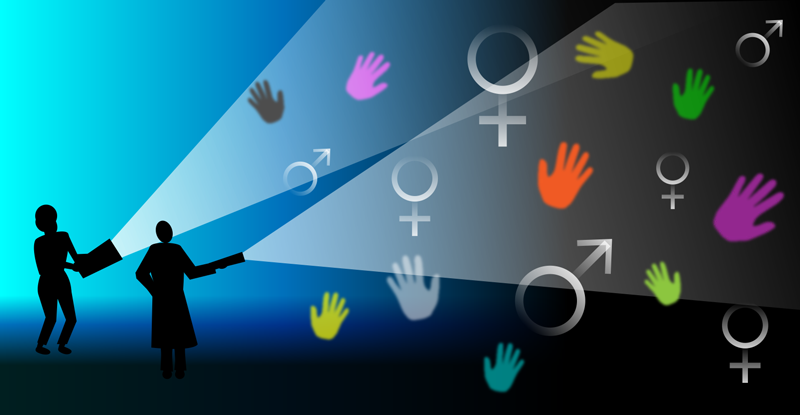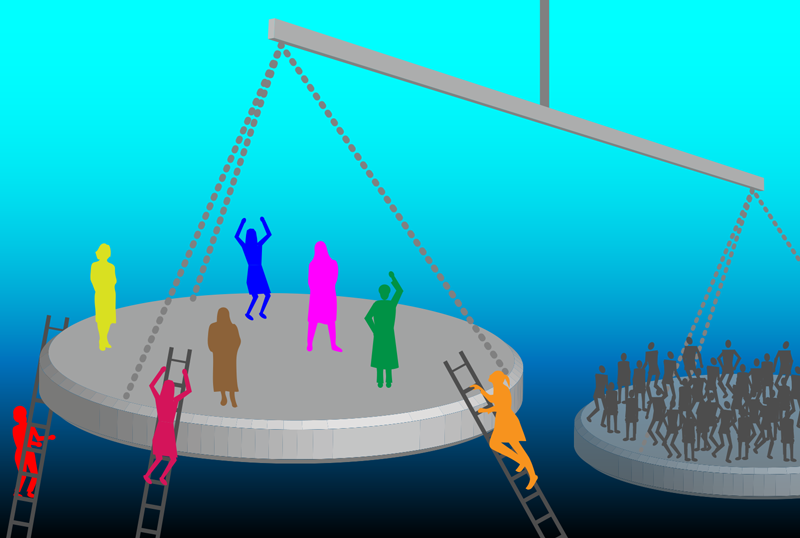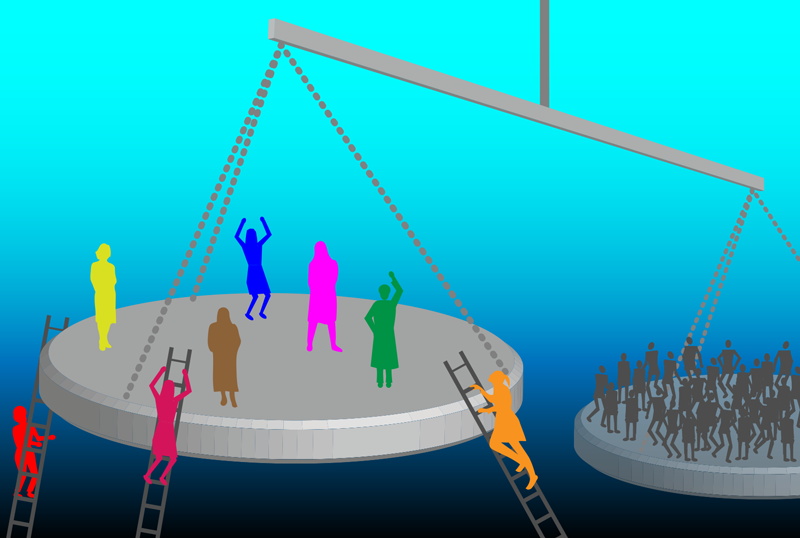Tackling Academia’s Publication Inequities
Scientists love data. Physicists at CERN generate 90 petabytes of data every year from particle collisions—enough to fill roughly 10,000 standard laptops, while astronomers working on the Event Horizon Telescope create so much data that it is quicker to fly it to their teams than to send it over the internet. Yet despite this love, some areas of science—for example, scholarly publishing—have a dearth of data. Researchers lack information on publication statistics, such as the acceptance rates of papers authored by women vs men and White vs BIPOC (Black, Indigenous and other People of Color) scientists. Having that data is key if academics are to implement effective practices for reducing gender and racial biases in science.
In light of growing research in this area, Physics asked three scientists who advocate for the collection of gender- and racial-disaggregated publication data to share their views. Marcela Linkova, chair of the European Research Area and Innovation Committee’s Standing Working Group on Gender in Research and Innovation, argues for the need for publishers to collect gender-disaggregated data that researchers can use to study disparities in the impact of COVID-19 on men and women. In a separate essay, Erin Teich and Danielle Bassett, soft matter physicists at the University of Pennsylvania, explain their analysis of citation data, which reveals large-scale undercitation of women and minority researchers. — Katherine Wright
Publishers Need to Provide Gender Data
It was clear from the first days of the pandemic that COVID-19 would differently impact the research careers of men and women. Working from home while homeschooling children or caring for infants was nearly impossible unless one sacrificed sleep, and, for the most part, women academics were taking on more childcare and domestic responsibilities than their male counterparts.
Initial studies suggest that this gendered “time gap” has translated into lower publication rates for women than for men across academic disciplines, including physics. But making these analyses is difficult because of limited access to gender statistics when it comes to publications. To fully understand the problem—and to take steps to mitigate it—it is essential that publishers provide gender-disaggregated data and that they analyze publication patterns to compare pre-pandemic, pandemic, and post-pandemic publishing levels. This gender data would be analogous to other metrics that journals provide, such as citation numbers.
This information will allow universities and funding agencies to better understand the impact of COVID-19 on men and women researchers and to better account for these differences in the countermeasures they develop. These measures are needed as the potential negative consequences of COVID-19 threaten recent gains for gender balance in academia. It is thus vital that institutions develop evaluation procedures that correctly account for time and publication gaps when giving promotions and that funding bodies consider them when awarding grants.
When the pandemic initially hit, some stopgap measures were enacted. For example, science funders extended grant application deadlines to allow researchers more time to draft applications. Some institutions also took measures to help carers, with ETH Zurich in Switzerland, for example, recognizing—as normal working hours—the time that their researchers spent caring for children or relatives. Multiple universities, such as the University of Leicester, UK, provided time-off allowances to staff working from home through special leave policies, while others, including the University of Durham, UK, and the University of Aberdeen, UK, introduced additional rest days for their research and teaching staff.
While these and other measures alleviate some of the immediate impacts of COVID-19 lockdowns, they don’t fix the underlying gendered time-gap issue. And it is not only the emerging publication disparities that are an issue. The time gap may impact other aspects of publishing, such as the availability of women to act as referees, which could have further negative consequences.
The reason for this potential impact is that both genders exhibit homophily, or positive gender bias, toward their sex in peer review, and research looking at ecology and evolution journals, biomedical journals, and geophysics journals shows that women are already under-represented among reviewers. With the care load increasing during the pandemic, women researchers will likely decline to review at higher rates. Studies also show a higher proportion of men among journal editors, another factor that can impact who reviews a paper. These two issues could lead to a lower acceptance rate for papers for which the lead author is a woman, a problem that may only worsen with an increased skew toward men referees. But to really get a handle on the problem—and then implement policies to mitigate it—we need more data.
The COVID-19 pandemic gives publishers and funders the opportunity to review their policies and start providing that data. Their first action should be a commitment to regularly compile and publish gender data for the entire publication process. This data would include—but not be limited to—the gender of the first, last, and corresponding authors of submissions and the acceptance rates for women and men reviewers of women- and men-authored papers. Publishers should also collect data showing the proportion of women and men reviewers together with their review-decline patterns.
Once they have that data, publishers should use it to address any gender imbalance. A simple rule of thumb could be that the percentage of women referees and editors should match that of women researchers in the field. Given the importance of the publication process for research careers and the communitarian values on which the peer review process is built, journal publishers could treat this change as a service to the research community as well as their contribution to fixing historical gender inequalities. Because clearly, we can and should do better. — Marcela Linkova
Combatting Growing Disparities in Citations
Gender and racial disparities permeate science. Women and BIPOC scientists are underrepresented at all levels of academia, and they are less likely to be awarded patents and grants. Disparities also exist in scholarly publication, with data showing that women typically author fewer papers and accrue fewer citations.
Citations are particularly useful to consider in the context of academic disparities. Citing other scientists’ work is an act that researchers carry out on a regular basis but often without careful consideration of its very real consequences. The number of citations that a researcher receives can impact the visibility of their work and the speed at which their career advances, for example, as citations are often used when determining whether to give a scientist tenure, an award, or a grant. Citation gaps between men vs women researchers, White vs BIPOC researchers, or researchers with intersections of these identities can thus have destructive consequences for equity in science. To fully diagnose the problem and to prescribe solutions, we need more data.
Collecting and analyzing citation data will allow researchers and institutions to develop practices to mitigate citation gaps. Our work analyzing citations of papers in neuroscience, as well as that of other researchers analyzing citations in fields as disparate as political science, cognitive science, astronomy, and international relations, shows that women are markedly undercited relative to men. We analyzed 61,416 neuroscience papers published between 1995 and 2018, finding that those that have men as first and last authors are overcited by 12% with respect to the citation rate expected if citations are accrued by a random draw from the pool of papers published prior to each citing paper. Papers that have women as first and last authors are undercited by 30%, for a citation gap of 42%. This gap persists even after accounting for where a paper is published, the length of its author list, the seniority of its first and last authors, the article type, and the publication year. This undercitation comes primarily from the citation practices of man-led teams. We found that papers with women as first and/or last authors cite much more equitably, overciting papers by men by 2.5% and underciting papers by women by 4.2%.
The same pattern is seen in the citations of neuroscience papers authored by racial and ethnic minorities, where White researchers are overcited by 8% and papers with BIPOC researchers are undercited by 17%. The intersection of race and gender proves especially devastating for citations, with Black women being undercited by 51%. White-led teams are the primary drivers of this inequality, since papers that have BIPOC researchers as first and/or last authors cite relatively equitably, overciting papers by White scientists by only 3.2% and underciting papers by BIPOC scientists by only 3.2% when accounting for paper features.
The urgency to address gender, racial, and ethnic citation gaps is underscored by the fact that the gaps are growing with time and are persistent across disciplines—our initial analysis of papers published in physics journals shows that the field also has this problem. So, what can we do to fix the problem and ensure that young scientists face a fairer future? Efforts to close gender and racial gaps often focus on the actions of people in positions of power, such as faculty or university administrators, conference organizers, and society presidents. These top-down approaches are invaluable, but scientists at all levels of seniority and influence can perpetuate imbalances.
To fix citation gaps, we need every person to act. One of us has described possible actions in another essay. We also provide a summary of tools below. Individual scientists can proactively close gaps by choosing references that reflect the diversity of researchers in their field or subfield, both in the ideas they present and in their gender, race, and ethnicity. Several journals, such as the Journal of Cognitive Neuroscience and Trends in Cognitive Sciences, now allow reporting of these efforts in the form of a quantitative index, which accounts for the gender balance of a paper’s citations relative to the overall authorship of the journal, or a citation diversity statement, which provides a transparent disclosure that diversity was actively considered when choosing references. Teams are building software and other algorithmic tools that allow users to assess the gender balance of reference lists, and Google Chrome now has an extension that adds gender to author names on papers listed on Google Scholar, PubMed, and other scholarly search engines. These tools enable researchers to change their citation behavior paper by paper. Individual actions can redefine the ethics of citations so that it emphasizes responsibility for and removal of the structures of inequality that have historically defined our fields and that continue to do so today. — Erin Teich & Danielle Bassett
Tools for helping achieve gender balance in citations
Citation Diversity Statement: A short paragraph, included before the Reference section, in which the authors consider their own bias and quantify the equitability of their reference lists. It states (i) the importance of citation diversity, (ii) the percentage breakdown (or other diversity indicators) of citations in the paper, (iii) the method by which percentages were assessed and the method’s limitations, and (iv) a commitment to improving equitable practices in science.
cleanBib: Jupyter notebook that calculates probabilistic gender and race/ethnicity estimations of authors within user-provided reference lists.
Balanced Citer: a GitHub repository that provides a python script to calculate the probabilistic gender and to estimate the race/ethnicity of authors within user-provided reference lists.
Citation Transparency: A Google Chrome extension that calculates and adds probabilistic gender information to the authors of papers listed in Google Scholar and PubMed searches.
GCBI-alyzer: A tool to calculate Gender Citation Balance indices (GCBIs), which quantify the gender breakdown of user-provided reference lists relative to the overall authorship of papers published in the Journal of Cognitive Neuroscience.









